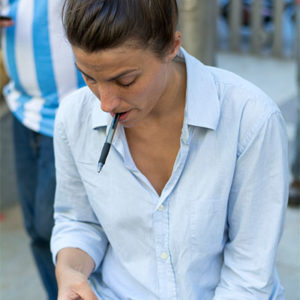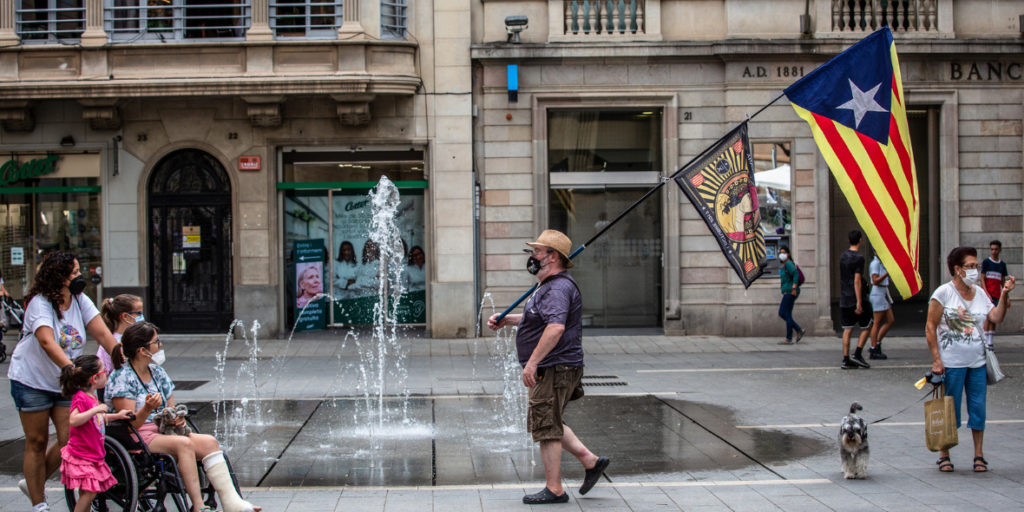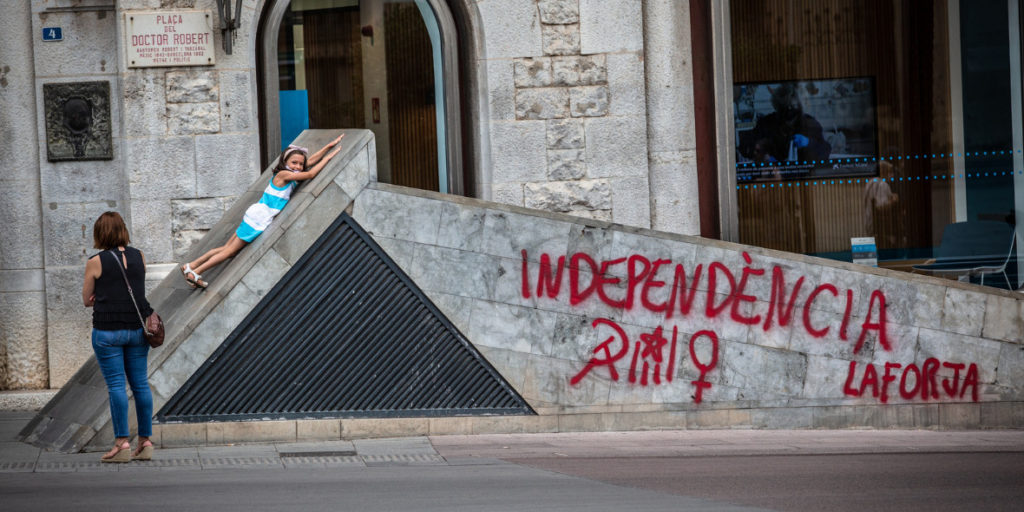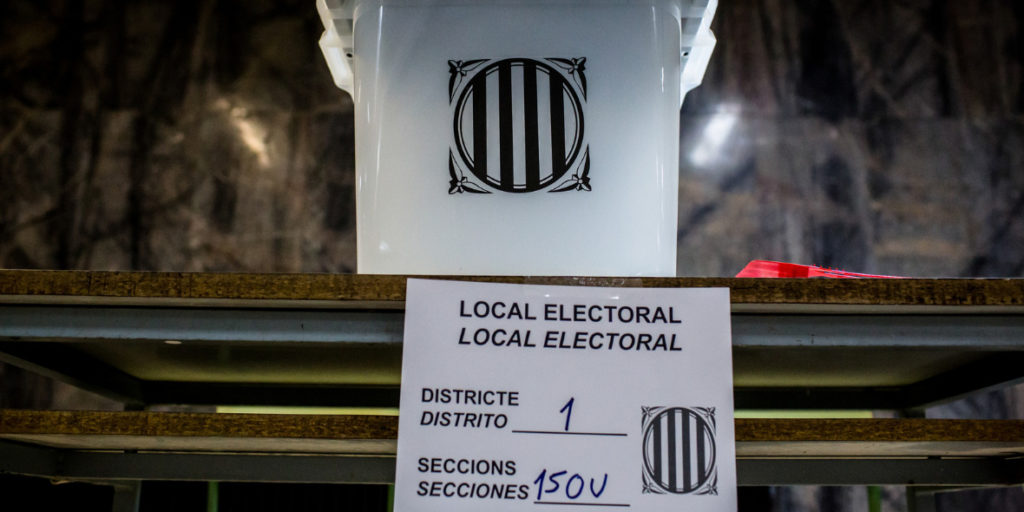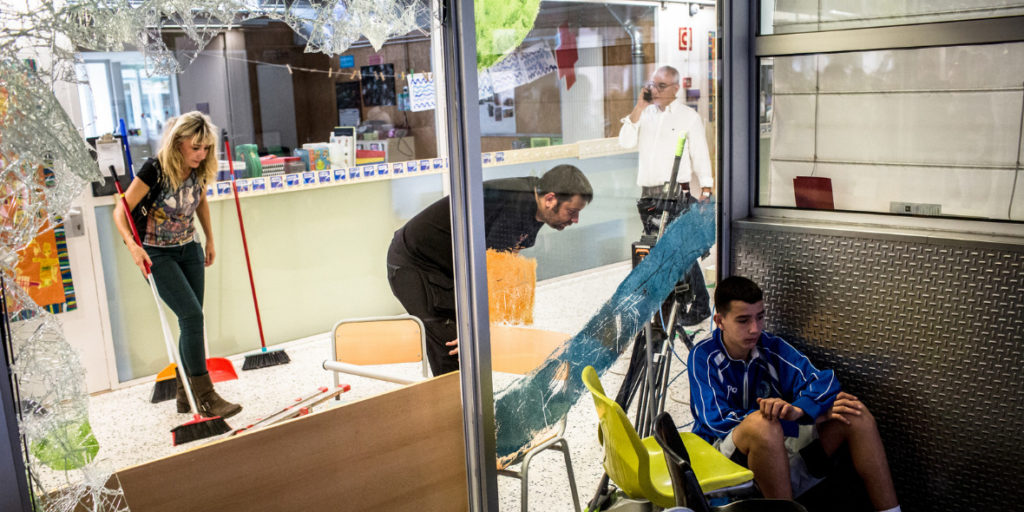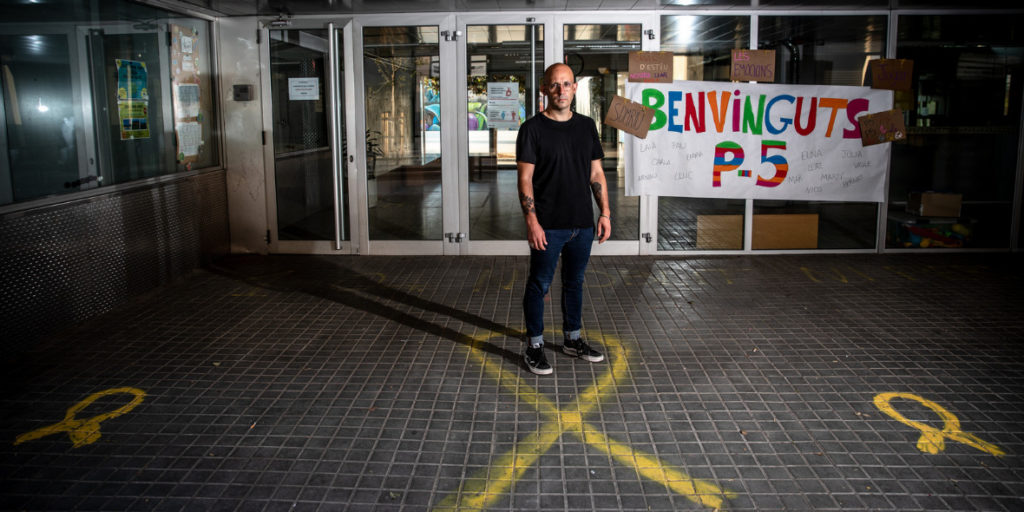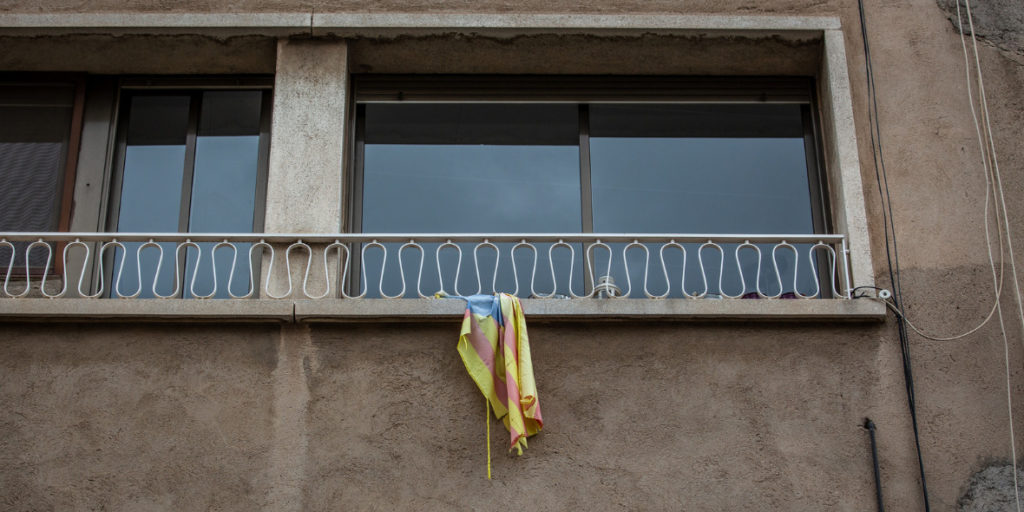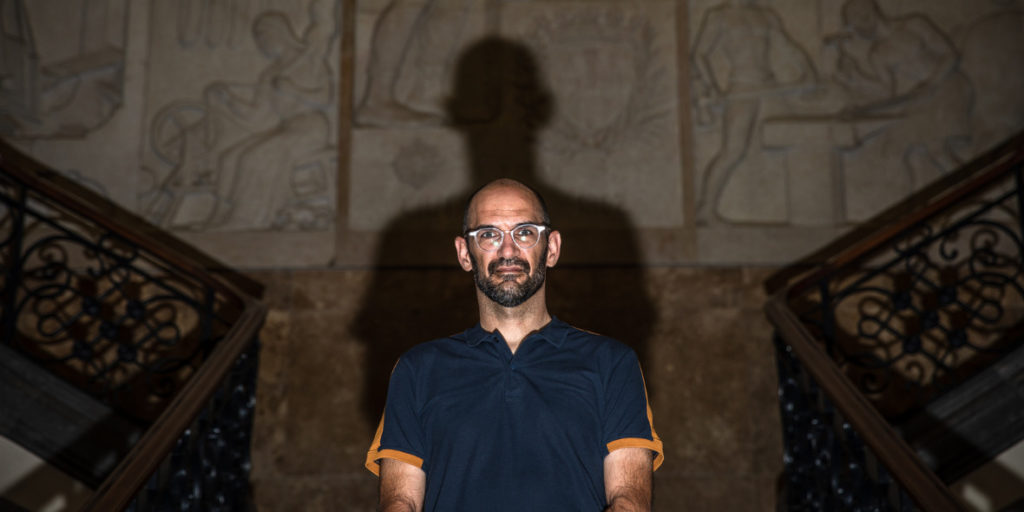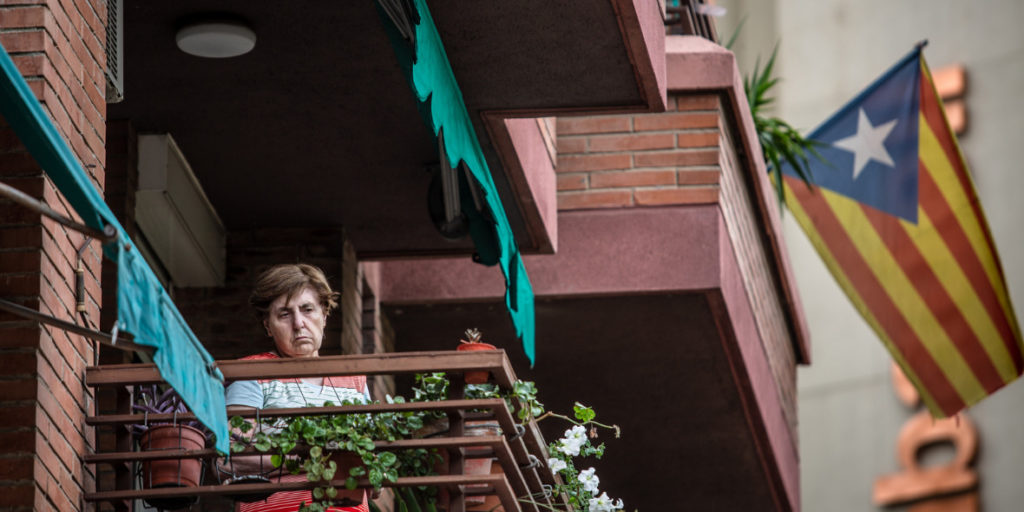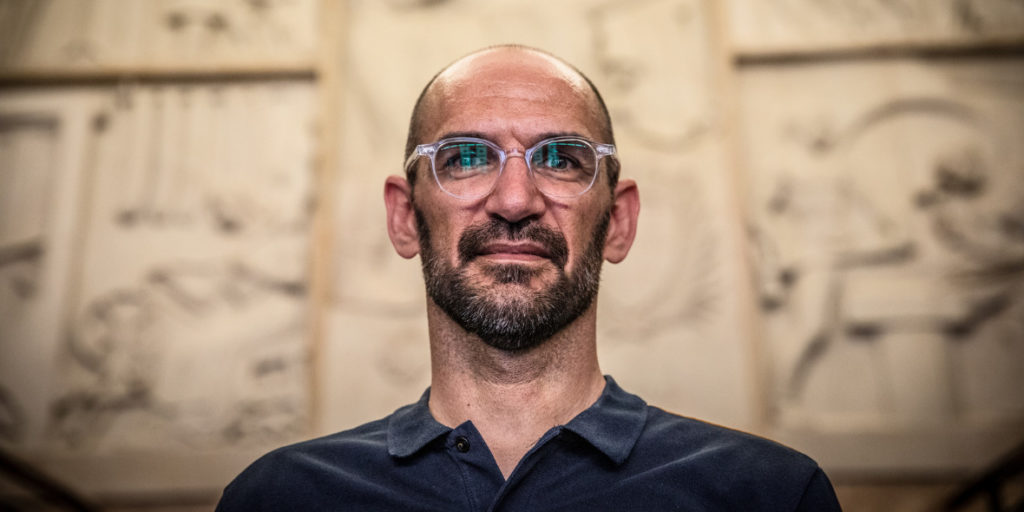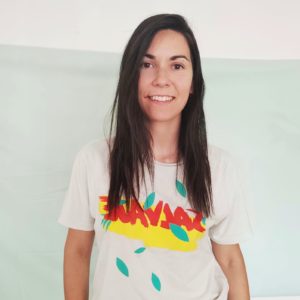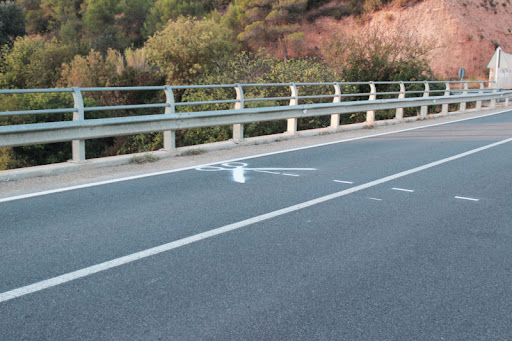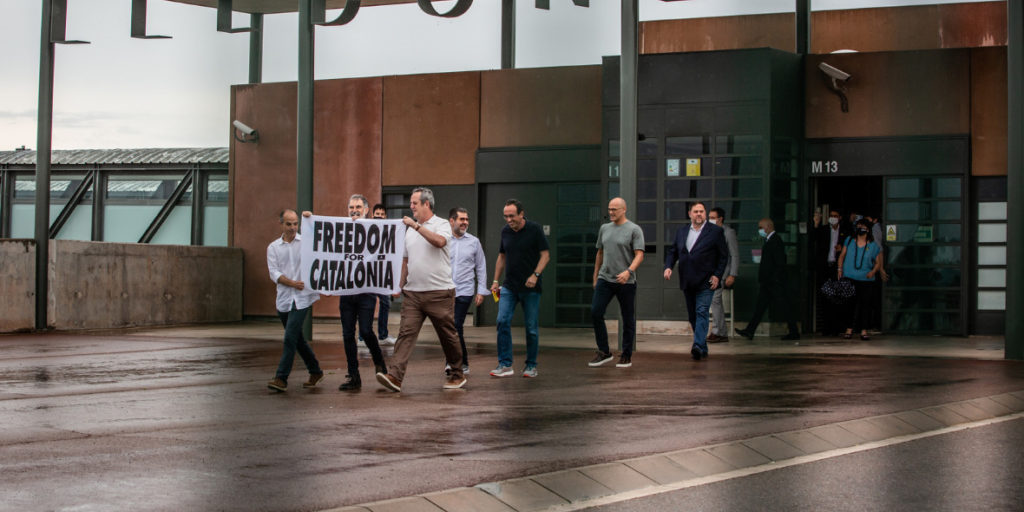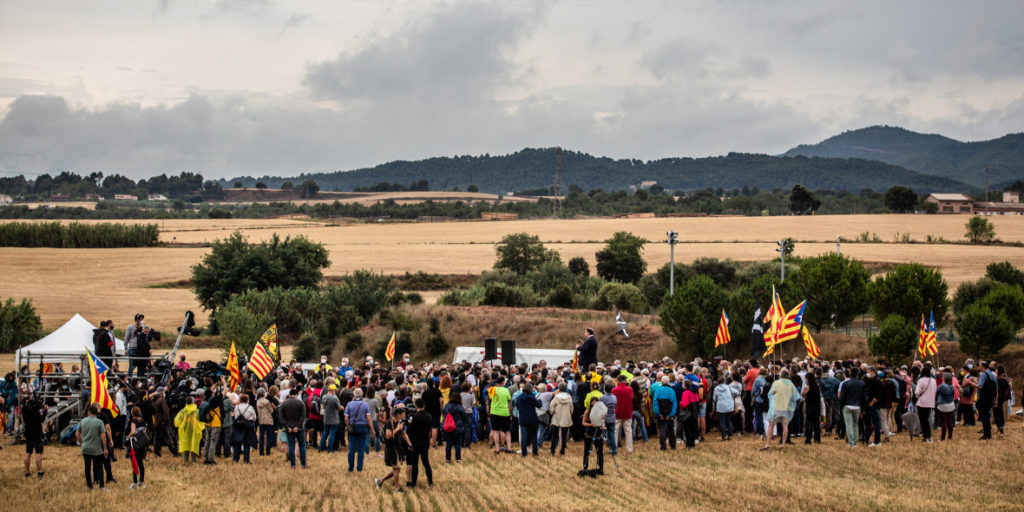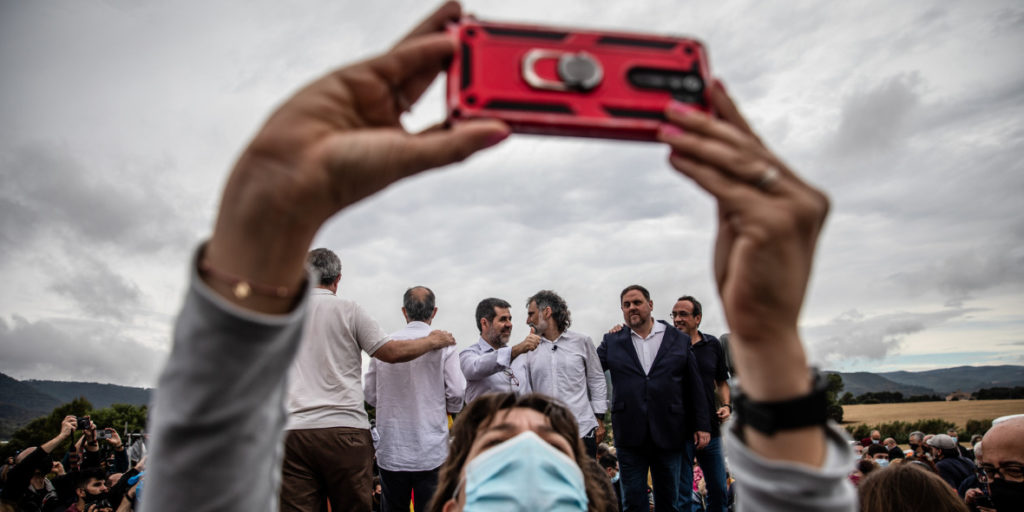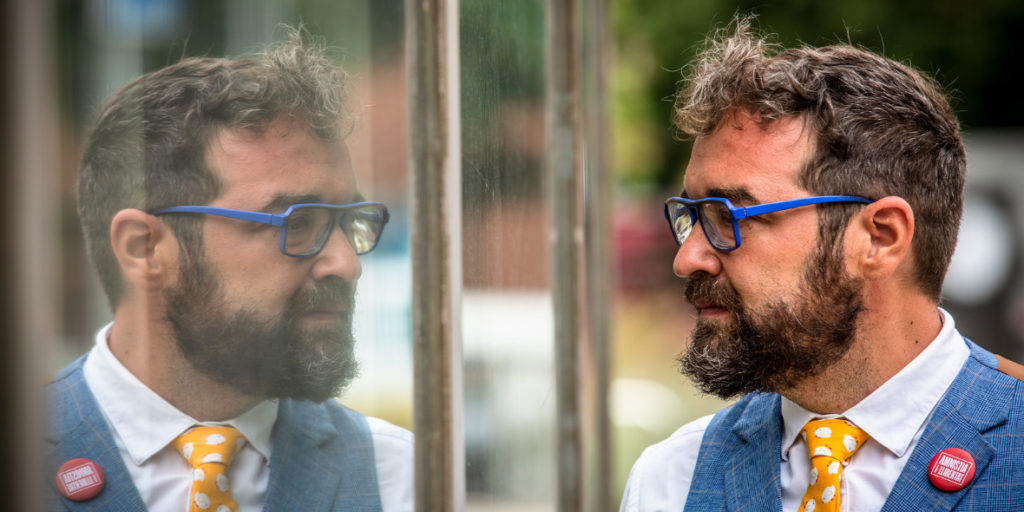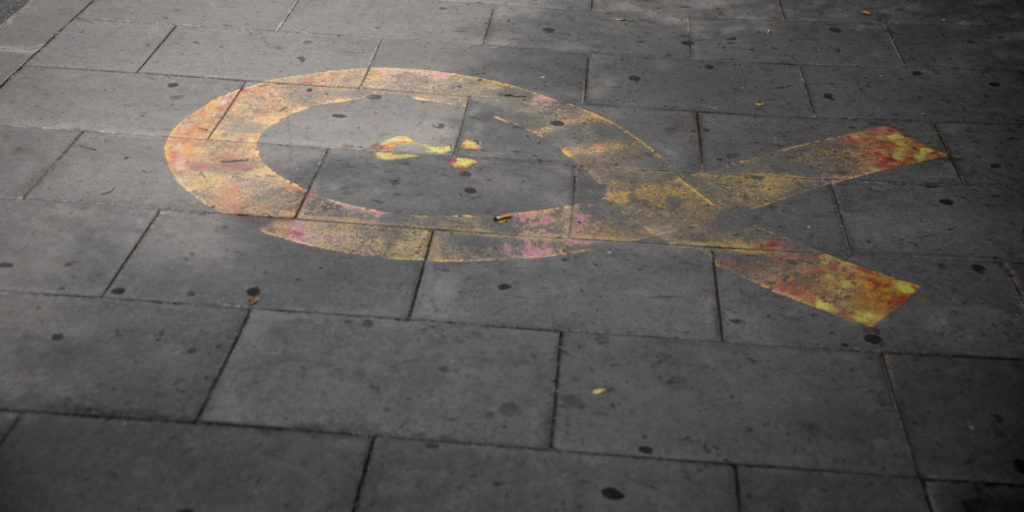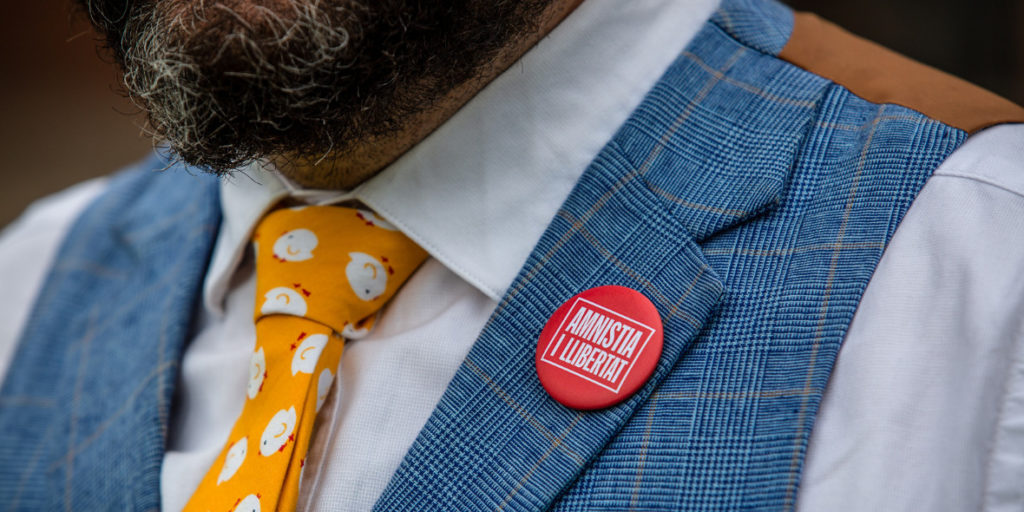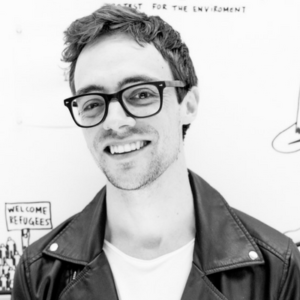In Sabadell, mass support for Catalan independence has given way to mass resignation. All that remains of the referendum of 1 October 2017 is the odd bit of graffiti and a few Catalan flags scattered about. 55,000 turned up to vote that day. But four years on – and a few months since the release of nine pro-independence political prisoners – what remains of the movement that was once so popular?
“Eighteen… twenty… there are twenty three of us today.” A few hardcore supporters of Catalan independence are gathered in the main square in Sabadell, a small city of 200,000 inhabitants 30km from Barcelona. They’re demonstrating beneath an enormous stone balcony which runs along the neoclassical facade of the town hall. Since June 2019, every day, at precisely 13:00, these citizens have been meeting to demonstrate against the removal of a large banner which was put up in solidarity with “political prisoners.” The new socialist mayor decided to take it down shortly after her appointment. “At first this square was packed,” says a nostalgic pensioner who prefers not to give us his name, “but now lots of people have stopped coming, they are demobilised.”
“Long live the free Catalonia!” The activists may be making a lot of noise with their megaphones in hand, but they are far from having the impact they had a few years ago. Around them, life goes on as usual. Few stop to pay attention. Even the police officer who’s guarding the entrance to the town hall is more concerned with his phone than keeping an eye on the demonstration.
“There were forty of us today,” shouts an inconspicuous man, slightly exaggerating the figure he’d cited a few minutes before. He claims the dip in attendees is due to the lack of leadership and clear objectives. “We used to have the goal of the referendum, we had a government that urged us to go into the streets. We did all that was asked of us: we protested, we organised a referendum, we held onto our parliamentary seats… Now we need to know what else we can do! The objective is no longer clear,” complains the protest leader, supported by other activists.
Nearly four years since the referendum on Catalan self-determination – which Madrid declared illegal – the daily protest in Sabadell is a snapshot of what’s left of the independence movement: these people are deflated and frustrated, but they continue to show up.
Just around the corner from the main square, Ricard Fernàndez sips a coffee while he recounts the events of 1 October 2017. A comic book artist in his 40’s, Ricard presents himself as a “circumstantial” supporter of independence. He is keen to insist he is “against the Spanish monarchic state” rather than “an advocate of Catalan nationalism.” Wearing a black t-shirt and trousers despite the heat, he looks like the singer in an alt rock band as he rolls another cigarette. In 2017 he volunteered to monitor the referendum. His role: to ensure the proceedings were fair, to keep an eye out for fraud, and ensure that all voters could express their preference freely. In a personal capacity, though, Ricard did not vote in the most recent Catalan elections.
His circle of friends share a certain “disenchantment” with the political class. This is true despite the fact that, thanks to coalition agreements, the pro-independence parties still enjoy a majority in the regional Parliament. “The parties themselves are not united, and they lack a common goal like a referendum. Without that there can be no real alliance. It’s sad,” Ricard muses between one cigarette and the next.
This sentiment is widely shared among the participants of the Diada march (Catalan National Day), which took place on 11 September in Barcelona, as it does every year. According to the organisers 400,000 took to the streets to call for independence, but it’s the first time that the movement has felt it necessary to declare the number of participants. The police, meanwhile, claim only 108,000 were present: a figure six times smaller than 2019. Aside from the decrease in attendees – which a few journalists have attributed to the pandemic – the parade was also marked for the first time by banners attacking Catalan pro-independence politicians, and accusing them of having “betrayed the mandate of the referendum.”
“1-0: never forget, never forgive”
To truly understand the demobilization of the pro-independence movement, however, one has to return to its apex. That fateful October – after years of political tensions in which the Catalan government clashed with the national, conservative government in Madrid – more than two million Catalans took to the polls to express their preference for self-rule (the organisers counted 5 million). The National Police Corps were sent to repress the vote, and they did so using considerable force. The graffiti “1-0: never forget, never forgive,” captures the importance of this moment for the movement’s supporters.
In Sabadell – the fifth largest Catalonian city in terms of population size – many people had been expecting the police to show up. This was especially true at the Nostra Llar school (“our refuge”, in English), where the then-President of the Catalan Parliament, Carme Forcadell, was due to vote. She was later found guilty of sedition together with her colleagues and, in 2019, was condemned to 11 years in prison.
“Catalonia triumphant
Shall again be rich and abundant
Drive away these folks
Who are so gall and arrogant.”
Ricard will never forget what happened. Four years later, he’s standing in front of the polling station where he spent the 1 October together with a handful of other volunteers.
From inside the building, Ricard watched as, one by one, the police rounded up the protesters gathered in front of the glass doors. Amidst the chaos, he didn’t notice that a few of the organisers were running off in the opposite direction, towards the corridors, with the ballot-boxes in hand.
The police entered, breaking down the doors. In footage from the helmet cam of one of the agents you can hear the shouts: “Where are the god-damn ballots?” Then the officer in question kicks down all the classroom doors. A few of his colleagues jokingly refer to their colleague as the “24 hour locksmith.” The keys to all the rooms were available at the building’s front desk.
Richard kept his cool and refused to sign the police report. The standoff lasted around thirty minutes or so. Outside, the protesters started singing the Catalan anthem: “Catalonia triumphant / Shall again be rich and abundant / Drive away these folks / Who are so gall and arrogant.” In the meantime, the officers threw a few boxes of toys into some large bin bags. “They wanted to make the people outside think they were taking the ballots away,” Ricard explains. He dwells on lots of little details like this as he tells his tale. As if he were putting a comic book together.
As soon as they’d gathered up their boxes of toys and the names of those present in the school the police departed, pushing their way through the furious crowd back to the vans. Then the ballots re-opened and voting resumed. The majority of those who came to the station, before the polls closed at 20:00, were supporters of independence. “I think it was the right thing to organise this referendum, even if, in light of what happened, it became purely anecdotal; the objective was to get the majority of the population to participate.”
Demobilisation
At the time Ricard had stopped smoking. The day after the referendum, though, he started again. “I didn’t think we’d win our independence, but I did think the Spanish government would recognise the political problem of having attempted to halt a democratic exercise using force, or at least acknowledge that what had happened wasn’t acceptable.”
In other words, after that historic day, Ricard, the Catalan people and the country in general were all expecting something to happen. Many hoped the Catalan government would make a unilateral declaration of independence.
That is indeed what effectively happened three weeks after the referendum, on 27 October 2017 – following a last, failed attempt to negotiate with Madrid – and under pressure from the pro-independence protesters who were calling for application of the “mandate of 1 October.” Two days later, part of the Catalan government fled to Belgium. The rest of the Executive ended up in prison, convicted on the charge of sedition.
For Ricard, as for many others, the sense of disappointment was profound. “We had a choice between, on the one hand, exacerbating a permanent conflict with an opponent that is stronger than us, and, on the other, hoping for a political process that could lead to a compromise; a compromise that Catalonia, Spain and Europe could agree on. But that hope never materialised.”
“It’s hardly news that to dismantle civil disobedience all you have to do is lock up 25 people. Friends and family members organise a solidarity initiative. Their priority is to get these people out of prison. And there you go, you’ve neutralised an entire movement.”
Ricard admits that the incarceration of one of his friends in September 2019 has also contributed to his sense of resignation.
It all happened when the sentence against the Catalan politicians was declared and a few groups such as the ‘Committee(s) for the Defence of the Republic’ (CDR) and ‘Democratic Tsunami’ tried to reignite the populace, promising serious actions on the anniversary of “1-0”. On 27 September, however, the Spanish Intelligence Services (CNI) authorised an “anti-terrorist” operation and, in Sabadell, they arrested nine suspects.
After around four months in prison, on charges of “terrorist association” and “possession of explosives”, the nine were set free. A few are awaiting trial. The others were acquitted on the basis of insufficient evidence. According to the investigation report, no explosives were found. Richard is pretty blunt about his feelings on the matter: “it’s hardly news that to dismantle civil disobedience all you have to do is lock up 25 people. Friends and family members organise a solidarity initiative. Their priority is to get these people out of prison. And there you go, you’ve neutralised an entire movement.”
The political long-game
Maties Serracant is also awaiting trial. But the accusations against the ex-mayor of Sabadell are far less serious. Seeing as he was in office during the events of October 2017 he’s in hot water with the Judiciary for having allowed the referendum to take place. 700 other mayors have been summoned by the Spanish courts on similar grounds. But most have got away with nothing.
Serracant is expecting an update on his case sometime in the next few months. “I’m optimistic. At worst I’ll get away with a ban from office, or with a fine. If you can condemn someone for having allowed people to exercise a fundamental right, the right to vote, then so be it! If that’s the case it would be more appropriate to condemn the violation of rights on the part of the Spanish state!”
The ex-mayor – sporting a modern 40-something-look – retired from political life at the end of his term in 2019. A geologist by profession, he went into politics to pursue a green agenda, then joined a pro-independence list that was made up of various local left-wing entities. After fifteen years of socialist rule, in 2015, his group, allied with other leftist independents, managed to take control of Sabadell.
Maties took the role of mayor during the second legislature, in July 2017. He remembers “1-0” as a historic day in which society self-organised democratically without the guidance of the institutions.
“I never lost sight of the fact that the city was not pro-independence per se. But the majority of citizens wanted to have the possibility of voting in a referendum,” he says, still amazed by the scale of public mobilisation. The mayor also went out to vote himself. Then he made a tour of the polling stations including, inevitably, the Nostra Llar school, where the broken glass had been cleared away and the ballot boxes were starting to fill-up once again.
For the ex-politician, that day was not about political pragmatism, it was a “test” that was “[designed] to demonstrate what it was possible to do, and that unilateralism was the only solution […] I also realised that a portion of the Catalan government was not prepared for this democratic uprising,” explains Maties. He who – apparently – had never wanted a political career.
Between Aragon and Catalonia: a fantasy border
“You’re lucky to be from the other side of the river”, my friend Natàlia told me back in 2017. The river Algars is located 220 km from Barcelona and forms a natural border separating villages of Catalonia and Aragon. It’s a rural and isolated region and I’ve been living here for most of my life. In a hypothetical independent Catalonia, the river Algars would form an international frontier.
In September 2017, Natàlia had just moved to my village after growing up and living in Barcelona. Despite her father coming from a small village nearby and even though she used to spend her summers here, she feels, and is Catalan. But for the first time, this feeling made her apprehensive.
The Catalan independence campaign and the media bubble it created infiltrated bars, shops, banks, even family meal times. While I was just a spectator of the events, Natàlia felt forced to choose between two sides. For her, there were more options than that.
The bridge crossing the river Algars connecting my village, Valderrobres, in Aragon, with Arnes in Catalonia was always a significant point for independence advocates in this region. In November 2017 a white stripe was painted on the road, splitting the bridge down the middle. People on both sides perceived self-determination was a real possibility. As the campaign got louder, more and more graffiti with pro-independent Catalan messages appeared on the bridge.
Still, while both towns have distinct and clear identities, there are strong cultural, linguistic and economic bonds between them. Catalan, for instance, is our mother tongue on both sides of the river, as well as for 17 other small villages in this Aragon area. Marriages between Catalan and Aragonese people are common. People have always been crossing the bridge without conflict. I haven’t observed a particular need to split.
Four years after the referendum, and the mobilisation of the movement, the issue has slowly become more blurred in our region. It is no longer the main topic of conversation between neighbours at the bars or in the shops. The independent Catalan flag still flutters when I pass through Arnes by car, but, for now, we don’t think too much about this symbol.
That which Matias calls a “democratic uprising” is defined as “sedition” by the Spanish Judiciary. After months of preventive detention, nine members of the Catalan government and other leaders in the pro-independence movement were convicted on this charge in 2019, for sentences of 13 years each in prison. The verdict provoked a week of daily demonstrations and clashes in the streets of Catalonia.
On 23 June this year, when the socialist government in Madrid offered these leaders a pardon, and the convicted were released from their respective prisons, only a few people came out to greet them. Two or three hundred dedicated activists gathered in front of the Lledoners prison that day, where seven of the accused had been enclosed for three years. To mark their release, the ex-leaders unveiled a flag that was embossed with the words “Freedom for Catalonia”, a gesture clearly directed towards the international news cameras.
Maties says he’s happy to be able to greet two of the ex-prisoners who live in Sabadell when he meets them in the street. He’s referring to the President of the Catalan Parliament, Carme Forcadell, and Jordi Cuixart, the leader of the Òmnium Cultural movement. Still, he was not there in person to celebrate their release. Instead he followed the events from his home, in front of the television.
The ex mayor admits that, from “1-0” on, the movement “has found itself on a downward trajectory and that, four years since the referendum, the heyday seems long ago.” Despite all the slogans from back in 2017 like, for example, “there aren’t enough prisons to hold us all” Maties ultimately agrees with Ricard’s analysis as to the brutal efficacy of incarceration. “The majority of the movement is not prepared to sacrifice that which would be necessary in order to win freedom [i.e. independence – ed.] Very few are willing to end up in prison.”
Nevertheless, Maties believes the decline in momentum is normal; a kind of physical and organisational necessity. “It’s like catching your breath: the movement needs oxygen to rebuild, to reconsider its role. I think it’s a good thing.”
“I don’t know a single supporter of independence who has changed their mind”
Julià Fernández, Maties’s colleague and his predecessor in the role of mayor of Sabadell between 2015-17, seems similarly unperturbed. Unlike Maties, Julià is still a regional deputy in the pro-independence left bloc the ERC [Esquerra Republicana de Catalunya – ed.] Buoyed by a strong result in the regional elections last February, which allowed his party to surpass the pro-independence right, Julià says he’s optimistic. “The movement is stronger and better than it was before,” he insists – a militant badge shining from his jacket.
Julià was also at Nostra Llar during the events of “1-0”, even though it was not his local polling station. He’d just had the feeling that something was going to happen there. “Given the police broke my glasses while they were clearing us off I only have a vague memory of that moment,” he explains. He quickly stops joking, though, and takes the opportunity to sweep aside the criticisms of the militant pro-independence activists who accuse the political class of inaction.
Demobilisation in the streets? According to Julià this is purely anecdotal. “I don’t know a single supporter of independence who has changed their mind”, he repeats. The lack of unity of the Catalan left and right at regional level is apparently of even less importance. The agreement to form a government, at the very last moment in May 2021, is the only fact that matters. Moreover, for he and his colleagues, a goal does exist: “to expand the base” of the movement and convince more people to join the cause. How? By demonstrating that pro-independence politicians are nevertheless capable of governing in the interests of people that don’t agree on that particular issue.
With this in mind Julià Fernández arranged to meet us in a square in Sabadell that he’s particularly proud of. It’s located in a neighbourhood where his party is polling at less than 10%. The space used to be a roundabout but during his mandate it was transformed into a playground. It’s also right at the exit of the train station that connects the suburbs of Sabadell with Barcelona. According to Fernández this type of local investment could convince more and more voters. Some might recognise the infrastructure as a symbol. Or perhaps even as an omen of some sort: for the ex-separatist mayor’s most dear project is nothing other than the restructuring of Plaza de España.
Scottish independence: if not now, then when?
Back in 2014 I spent a very rainy summer knocking on doors in Edinburgh, trying, unsuccessfully, to convince folks to vote YES in the referendum on Scottish independence. A lot of my friends disagreed. I get that. I also find nationalist pageantry, flag waving and so on, pretty cringe-worthy. The hardcore Catalan separatists, who argue they should have their own state based on their unique language and heritage, seem particularly misguided to me. Nations are always pluralistic, and that’s a good thing.
Yet for me the Scottish issue isn’t really about identity. It’s about challenging the anti-democratic architecture of the British state. Every other European country has a written constitution, which, however imperfect, protects citizens from the whims of any given government. In the UK we have no such thing. Instead, we simply allow lords and lawyers and ‘life time peers’ to improvise fundamental principles according to uncodified rules. Scots have been protesting against this obscure system for decades, and in 1997 we won a devolved parliament. So why not go the whole way?
I don’t hate the English. I can’t stand bagpipes. And don’t even get me started on haggis. The democratic case for independence, though, is only getting stronger. In 2016 Scotland voted 62% to remain in the EU. Not one district supported leave. Nevertheless, Westminster forced Brexit on the country. In this spring’s local elections, Scots responded by giving the pro-independence SNP (and Greens), an overwhelming majority. Honestly, long-term campaigners like me are still recovering from the last defeat. But with so many people now warming to our arguments there’s an opportunity here that shouldn’t be wasted.
*Reporting on the ground in Sabadell took place in August 2021.

